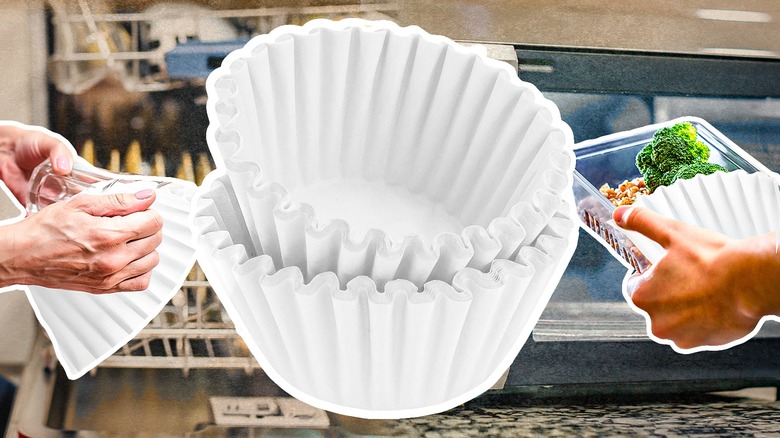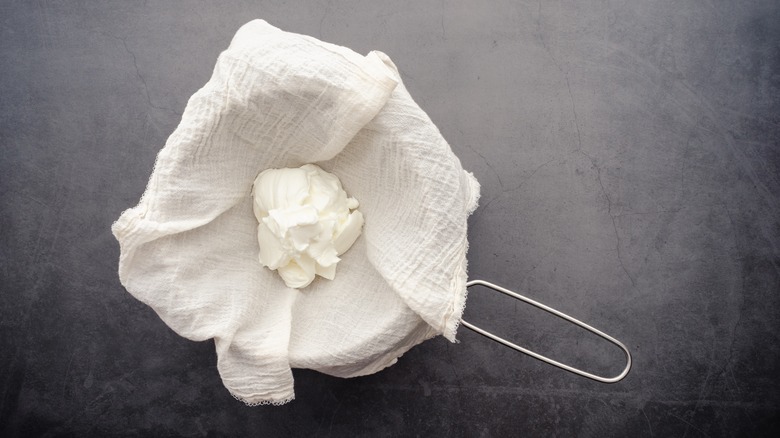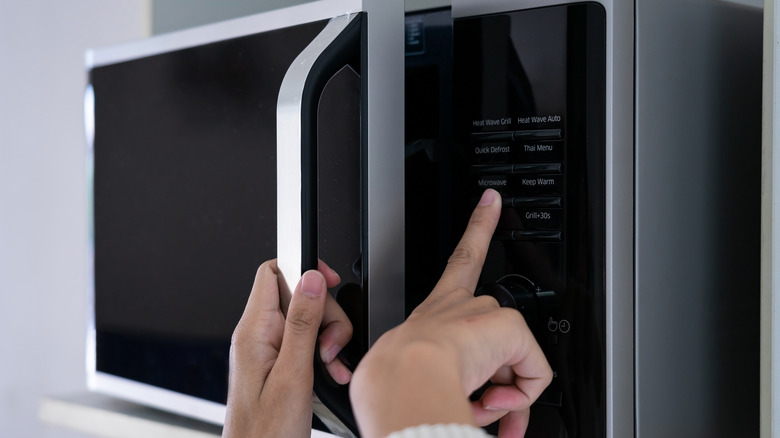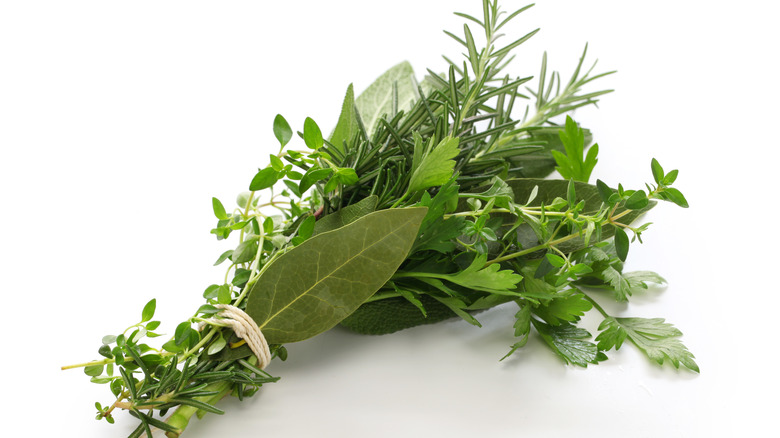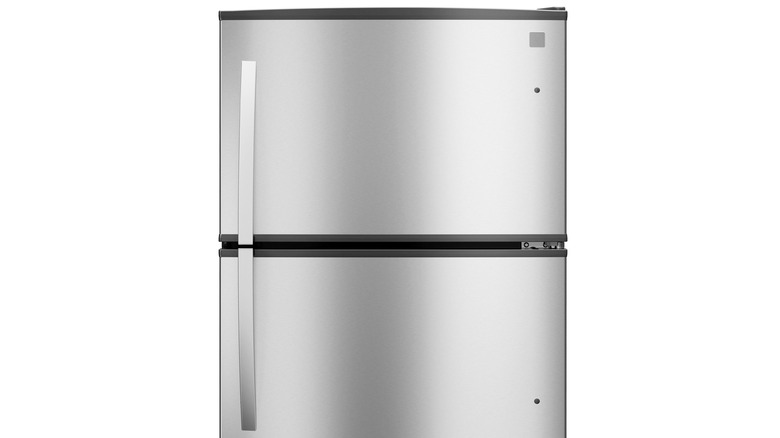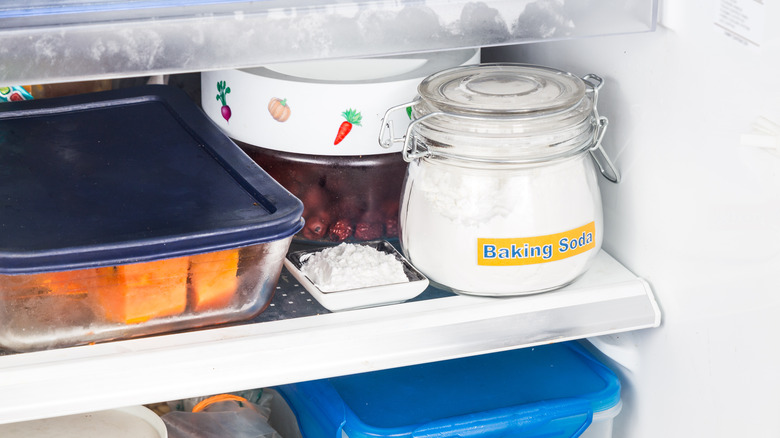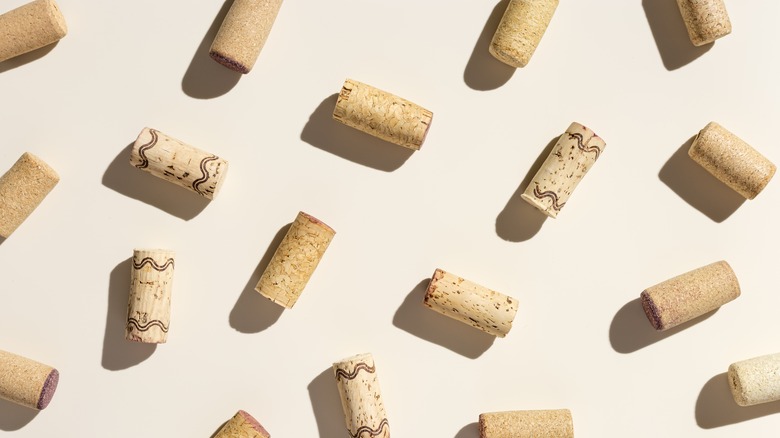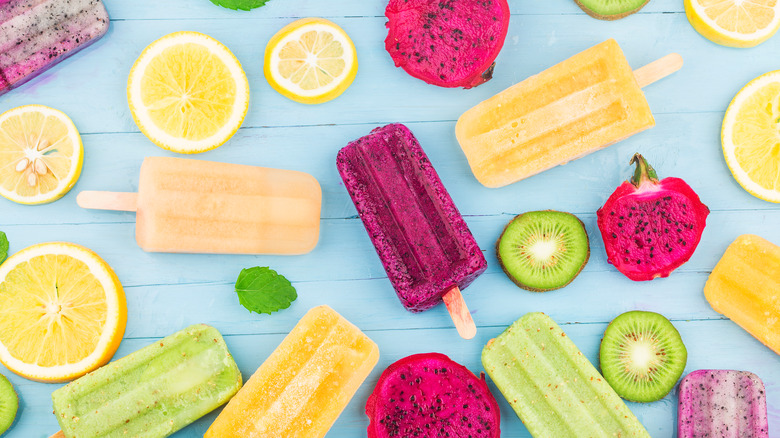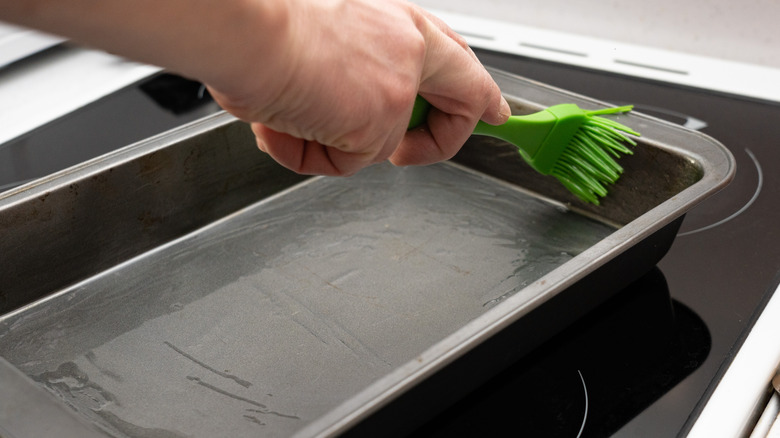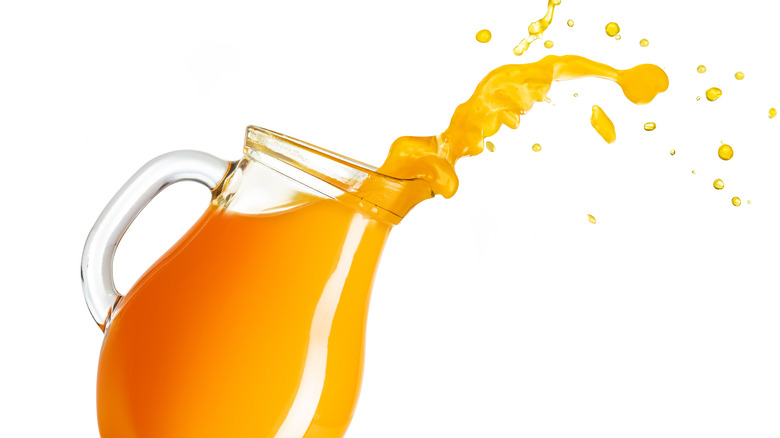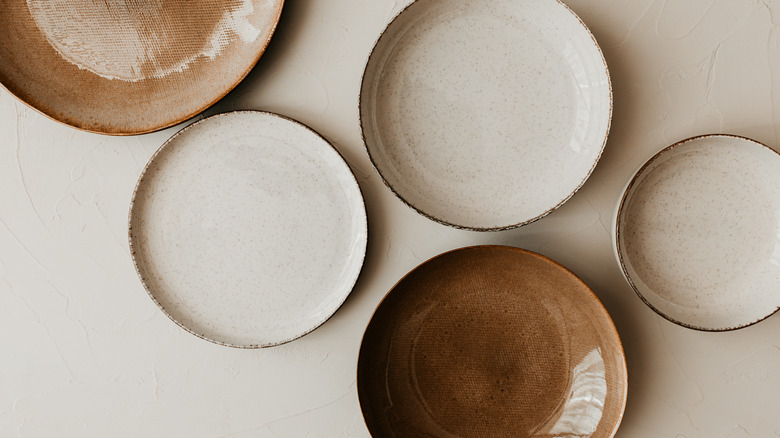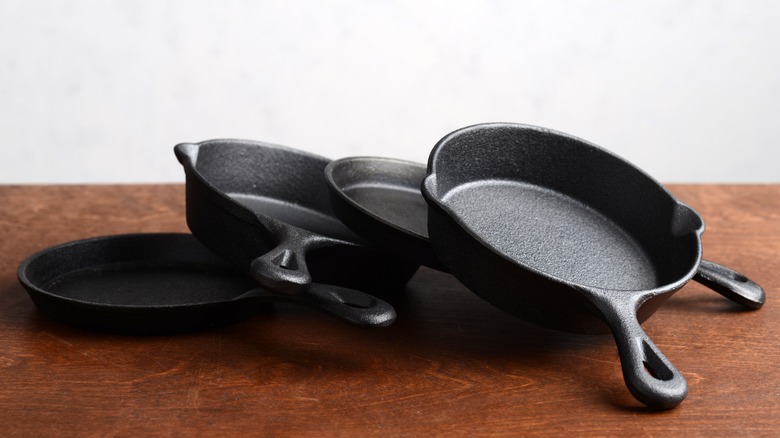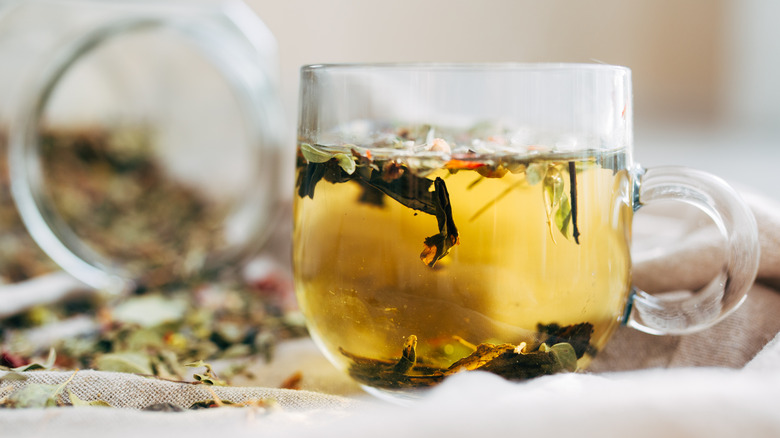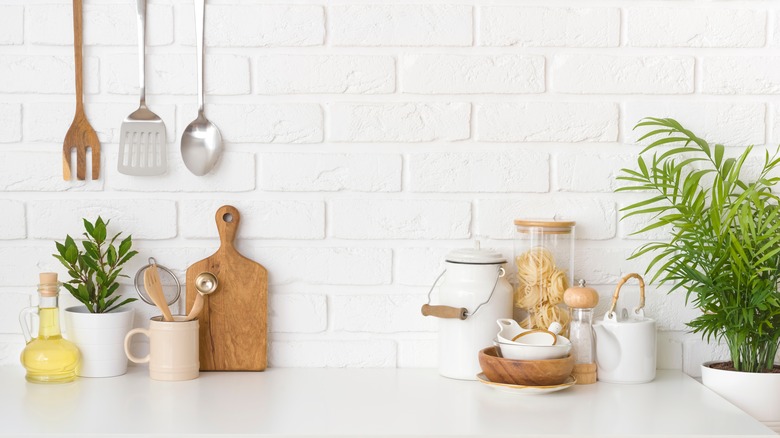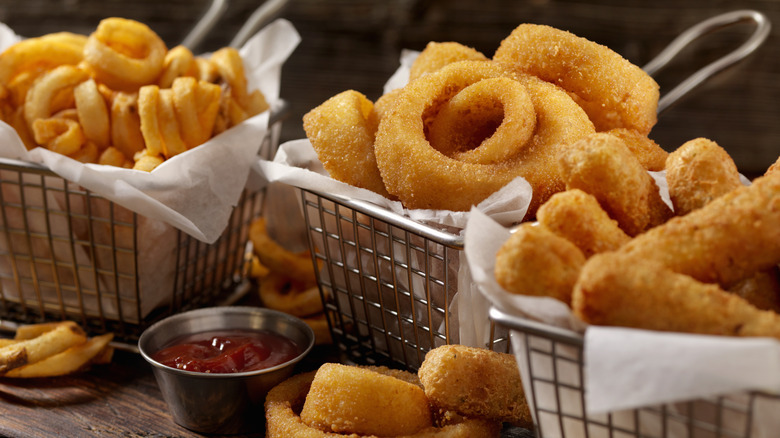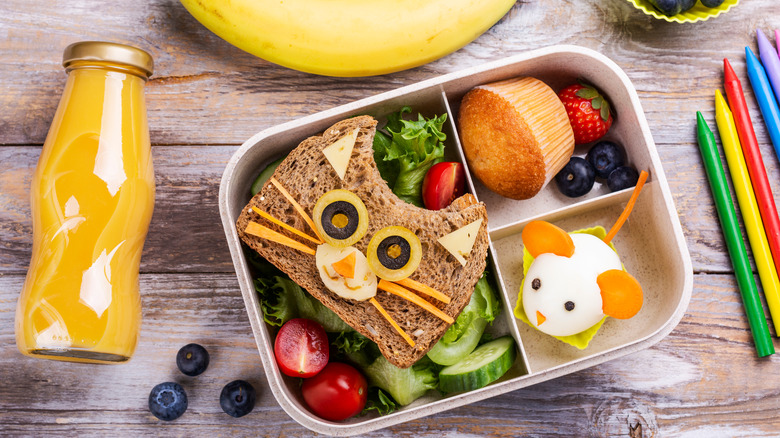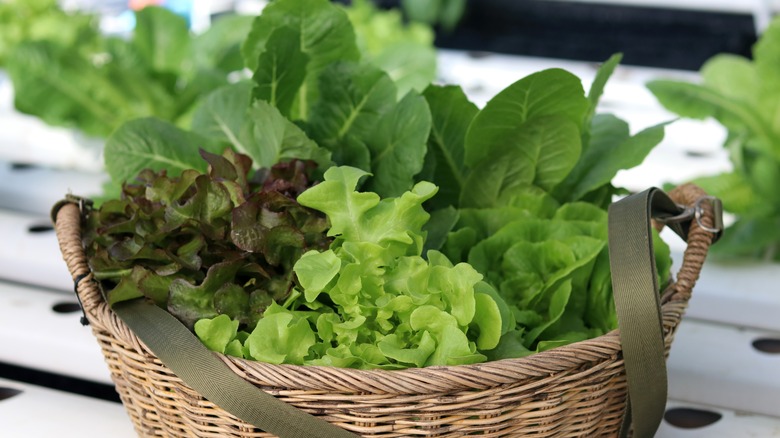20 Ways To Use Coffee Filters Other Than Brewing A Cup
For many of us, a hot cup of coffee is as crucial to our morning routine as brushing our teeth or changing out of our PJs. While there are an ever-increasing number of coffee shops to choose from, no matter what city you live in, brewing your morning cup of joe at home can be an enjoyable ritual and a great way to save a little money. It also allows for exploration and a wide variety of methods, from cold brews to filter coffees to aero press, each involving its own type of coffee filter.
While saving your coffee filters for coffee would be perfectly fine, it's also a fun, creative, and economical exercise to discover other ways to use them that may have never crossed your mind. For those who brew their coffee at home, the likelihood of having coffee filters in the cupboard is high. And, with each package containing many individual filters, it can be beneficial to know what else they can be used for, just in case a situation arises that calls for quick adaptive thinking, too. Here are 20 ways to use paper coffee filters; something to contemplate over your next cup of coffee.
1. Use in place of a cheesecloth
One of the tastiest ways to use a paper coffee filter for food that's not coffee is by using it as a substitute cheesecloth. Simply straining full-fat, plain yogurt through the coffee filter, you can create several delicious dairy products, including thick, Greek-style yogurt and an even thicker yogurt cheese called labneh.
To make either Greek-style yogurt or labneh, place your filter into an equally-sized but deeper cup or glass, and secure the coffee filter with a rubber band along the edges to suspend it in place, ideally an inch or two above the bottom of the glass, then let it strain away in the fridge. For thicker yogurt, a few hours is all you need. To make labneh, you'll want to strain it overnight or for up to two days to create the desired texture. Afterward, feel free to season with citrus, salt, or herbs for labneh or freshly cut fruit or cinnamon to compliment your Greek-style yogurt.
2. Cover food in the microwave
When it comes to using microwaves, reheating can sometimes be a splashy, splatter-filled business. No one wants to spend more time cleaning up from the reheating process than eating. Here's where having a spare coffee filter is handy in this situation — turn the filter upside down to cover your food before pressing the 'heat' button.
Not only will this help keep food inside the bowl or plate where it belongs, but it will also save you a bit of elbow grease by keeping the sides of your microwave sauce free. If you want to reheat a roll, burger bun, or bread in the microwave but don't want to risk it drying out, you could also use a damp coffee filter in place of a piece of paper towel, to create fresh-from-the-oven results.
3. Make a bouquet of garni or other spice infusions
Though they may seem understated or even unnecessary at times, the value and flavor herbs and spices impart into a dish can often mean the difference between a good dish and a great one. There are a variety of ways in which to use these seasonings, from toasting and tempering, as is common with whole spices, to infusing, a technique used when adding a bouquet garni to a dish.
The name bouquet garni comes from French and means "garnished bouquet." Within French cuisine, these often consist of a combination of bay leaf, thyme, and parsley, all fresh and bound together with cheesecloth and a bit of cooking twine. However, you can also easily wrap and secure the herbal combination in a coffee filter. Not just for a traditional French bouquet garni, a coffee filter can also help with any spice or herbal infusion, adding depth of flavor to any dish or meal.
4. Clean stainless steel appliances
Slick, modern, and professional-looking stainless steel cooking appliances and equipment have become standard in today's domestic and professional kitchens. Stainless steel is durable as it is versatile. However, those with beautiful stainless steel appliances like refrigerators will know the pain of constant fingerprints and smudges. Next time you go to wipe them away, consider using a paper coffee filter instead of the standard go-to cloth or paper towel for a streak-free finish that will last until the next person in your household reaches for a snack.
Like with their cleaning, cooking with stainless steel can take also a bit of getting used to, from knowing how to unstick food from a pan to properly cleaning your pots and pans (no steel wool!). However, it is worth taking the time to hone in these cooking and cleaning skills, to make the most of these high-quality products.
5. Employ it as an air freshener in the fridge
When people say food brings us together, they're usually describing cultures or families coming together to share food at the table, rather than your family gathering around the fridge to play a guessing game of where the funky smell is coming from. For those who have been players of that game and wish never to do so again, another possible way to utilize a pack of paper coffee filters is to create a homemade room and fridge deodorizer.
Making your own fridge deodorizer is easy. All you need is one coffee filter, baking soda, and a twisty tie to help neutralize any funky-smelling area in your home, from the fridge to the bathroom. Add a few spoonfuls of baking soda to the coffee filter, then twist and secure with the tie. If your deodorizer needs to sit in a high-visibility area, add a pretty ribbon or two, and voila!
6. Dry glassware with them
When it comes to getting streak-free results from your glassware, mirrors, and windows there are a lot of tricks and suggestions out there from newspapers to vinegar. Unsurprisingly, coffee filters can also be quite effective, some say more so than paper towels or even cloth. This is due to a coffee filter's lack of lint, which can often get left behind on glass windows and glassware, requiring even more elbow grease and buffing to attempt to remove.
To use a coffee filter to dry and polish a wine glass, begin by holding onto the stem itself, working your way from the outside base of the glass upwards. Once the outside is sparkling, you'll want to move onto the inside of the glass, including the lip. The movie tropes of servers and sommeliers holding a wine glass up to the light are based on fact. By doing this you'll be able to see otherwise easy-to-miss streaks. Finally, once you have a streak-free result, use the coffee filter itself to help prevent smudges while you carry it to the table.
7. Strain bits of cork from your wine
We now live in a day and age where many corks on wine bottles are rubber or even screw top, once markers of a lower quality wine but no longer the case. Around 30% of wine bottles are screwtops, which can help keep wine fresher for longer with a tighter seal. That said, there are still several varieties that use cork stoppers, which ultimately means at some point, wine drinkers will experience wine cork breakage, leaving bits of cork bobbing up and down in your favorite bottle of sauvignon blanc or merlot.
For those in this position, we suggest pouring the bottle of wine, corks, and all through a coffee filter into your decanter. Just like it does with coffee grounds, it is the perfect fuss-free solution to cork in your wine and is so much more efficient than trying to scoop out all the little bits yourself with a spoon!
8. Catch drips from ice creams or popsicles
Anyone who has ever lived in a warm climate for even a few months of the year can attest there is nothing quite like a cold, frozen dessert on a hot day. However, the combination of warm air and a sugary-frozen item, especially when placed in the hands of a child, often results in a sticky, melty mess. For those looking for a quick solution to reduce the likelihood of sticky fingers or a t-shirt stained with homemade popsicles, we recommend turning to the paper coffee filter again.
Whether you're indulging in a cone of mint chocolate chip or a hibiscus-flavored bolis de Jamaica, drips are likely, if not guaranteed. To mitigate this, simply insert the bottom of your cone or popsicle stick into the center of the coffee filter, piercing through the paper. Create a skirt-like drip catcher around your popsicle, or simply keep the open filter where it is around the cone, not wanting to rip the paper too far.
9. Save cooking fats
One of the best not-so-kept secrets is just how versatile and flavorful a bit of saved and reused cooking fats can be. Want to make your weekend brunch of eggs even tastier or your homemade French fries even more spectacular? Cook them in a bit of reserved bacon or beef fat from your last BLT or roast dinner. The question then becomes not if but how to safely save and reuse these cooking fats for maximum flavor and potential. The answer lies in the humble coffee filter.
When reusing oils or fats of any kind, any extra pieces of cooked food can quickly turn a precious jar of carefully saved fat into a rancid mess that can ruin your dinner. By carefully securing a coffee filter over a jar with a rubber band, then very slowly pouring the cooled fat through the filter, taking care not to let it build up in a puddle and risk solidification, you'll guarantee future success in the kitchen. After you have completely strained the cooking fat, replace the seal-tight lid and store it in the fridge for up to six months, dipping into it whenever you want to add extra flavor to a dish.
10. Grease your baking trays or pans
Baking recipes often begin with two quintessential instructions: preheat your oven and grease your pan, tray, or baking sheet. While the first step is about as straightforward as possible, step two can be achieved in various ways, subject to what you have in the kitchen.
There are quite a few hacks to greasing a baking tray well, from using the wrapper from a stick of butter to using your fingers and a bit of oil to grabbing a kitchen towel. A coffee filter can also be a handy tool in helping spread out the oil, butter, or whatever cooking fat you might be using, to create a thin, even layer around the entirety of the surface. That said, you want to ensure you've read the recipe thoroughly before beginning the greasing process, as some may advise against greasing your cookie sheet to prevent a limp biscuit or cookie.
11. Remove the bits from citrus juice
When it comes to freshly made orange juice, there seem to be two distinct camps of thought: those who like all of the pulpy 'bits' and those who prefer to drink rather than chew their orange juice. Coffee filters are an excellent option for those who prefer a smoother drink and for anyone looking for an easy way to remove the pips from their freshly squeezed lemon, lime, or grapefruit juice.
Whether pouring directly from a carton or hand squeezing the citrus yourself, using a coffee filter to strain away the fleshy bits of fruit and seeds is a handy kitchen hack to help you avoid getting pips into your freshly made lemonade. It can also save you from buying two kinds of orange juice at the store if serving a family with mixed opinions on orange juice with 'bits.' Strain half of the container by pouring the liquid into a coffee filter placed over a pitcher to appease everyone at the table.
12. Protect your plates and chinaware
While most wedding registries are not the china-filled gift lists they once were, caring for whatever tableware you have, whether it's bone china or mismatched plates found at the local thrift store, is essential. Keeping plates and bowls chip-free will extend their life and use significantly, so no matter what you choose, treating each piece with a bit of care is worth the investment.
One idea to help keep your crockery looking its best is sliding a coffee filter between plates, bowls, saucers, or even tea cups as you stack them. By removing some of the friction caused by dish-on-dish action, you can reduce possible chipping, cracks, and breakage, removing the worry that your favorite piece of crockery might not make it to your dinner table. This extra step frees up your mind and your budget for a splurge of a candle, table runner, or bouquet of flowers, all welcome additions to set a beautiful table.
13. Protect cast iron pans from rust
Cast iron pans seem to be having their 15 minutes of fame; it feels like they're everywhere! It's not just our perception; cast iron pan sales have seen a 225% increase in the last ten years, making it much more essential to understand how to use and store these popular products for best use.
Once correctly seasoned, good cast iron can last a lifetime if well kept. However, rust can often plague this type of cookware, as it will react to any excess water or moisture if not properly dried before being stored. Want to go the extra mile to ensure your cast iron remains rust-free? Just pop a few coffee filters on the pan before tucking it away to help absorb any possible moisture and reduce the risk of rust.
14. Create your own tea bags
Whether hot or cold, teas have a vast range of flavors, including various plants, spices, herbs, flowers, and berries. For tea lovers looking to branch out and explore, a paper coffee filter is a fantastic way to start the journey of creating your own unique tea blends.
To make your own bespoke tea bags, simply cut the filter into more of a rectangular-like shape, add your tea blend, and fold to secure it on all sides. You can seal it with a single staple, attach a piece of twine, and presto; your next brew awaits. These also make lovely and eco-friendly holiday gifts, allowing you to create thoughtful personalized teas and bags for friends and loved ones at little cost.
15. Turn it into food wrapper for on-the-go foods
Living in a fast-paced world often means a need for grab-and-go meals. However, just because life is busy doesn't mean we can't find ways to enjoy our favorite foods even if on the run; we just have to think creatively about making them easy to eat while mobile, which is where a coffee filter can be a real asset.
For those who don't want to miss out on foods like tacos, grilled cheese, or quesadillas, you can use a paper coffee filter as a wrapper, reducing the risk of mess. So make your famous breakfast quesadilla, then wrap it up in an absorbent filter and hit the road. Doing so will allow you to nibble away on your commute to work without transferring greases from the cheese onto your hands.
16. Use as biodegradable snack bowls for parties or picnics
When it comes to individual-sized containers, we need to get better at finding alternatives to plastic, especially single-use plastic. Enter the unbleached coffee filter to answer the call. Whether you're looking for a fuss-free container for on-the-move (or even just on the couch) snacking or disposable, biodegradable containers for party snacks, the coffee filter can be a great and inexpensive little hack. Give guests their own bowls of popcorn at your next movie night, or easily dole out the goldfish crackers to your kids during your next road trip.
Unbleached paper coffee filters make for a perfect container you can compost when the film, birthday party, or trip is over. Better for the earth than some of the alternative plastic options and better for your budget than some of the other eco-options on the market, too.
17. Rest cooking spoons
When it comes to keeping counters looking clean, a spoon rest is one of the best and perhaps undervalued tools in the kitchen. Especially when working with ingredients and sauces notorious for staining (we're looking at you, red wine, beetroot, and tomato sauce), having a spoon rest can save any cook from the need to use elbow grease and effort trying to remove food stains from countertops.
When in a pinch, say, while staying at an Airbnb or renting a cottage for a summer getaway, a coffee filter can double up as an excellent spoon rest. They're known for their absorbency and ability to catch drips. They're also just the right size and shape to hold a wooden spoon or spatula. Bring on the bolognese and the borscht!
18. Remove excess oil from freshly fried foods
There are so many ways to incorporate the humble paper coffee filter into daily cooking and food prep. Those with a penchant for deep-frying at home might be pleased to know that you can use a coffee filter not just once but twice throughout the process.
Any standard paper coffee filter is an excellent tool for straining and reserving previously used cooking fats for frying. When it comes to frying food, whether pan frying or deep frying, a paper coffee filter also works much like a kitchen towel. By laying your ingredients onto paper towels or coffee filters after cooking, they will absorb and remove excess grease, leaving food crispier, fresher, and ultimately tastier. So, if you find yourself with chicken schnitzel on the dinner menu but not a single paper towel in sight, there is no need to panic. Coffee filters to the rescue!
19. Keep packed lunches from becoming soggy
No matter what cute note you might write, or treat you pack, for young children (and sometimes grownups too), a soggy sandwich in a packed lunch can wield the power to overwhelm and ruin the entire lunchtime experience. No matter what age you are, no one wants to leave the lunch table feeling hungry.
Avoiding a soggy sarnie is a relatively easy fix, simply by placing a coffee filter on or around the sandwich before sliding it into the lunchbox. While there are also lots of different healthy school lunch ideas that don't involve sticking something between two pieces of bread, a great sandwich that won't go limp in the lunchbox is a great weapon to have in anyone's arsenal — parent or otherwise.
20. Keep lettuce crisp
Reducing waste in the kitchen, from resisting the urge to overbuy to adopting a top-to-tail cooking method, is a great practice for many reasons. Not only does this kind of thinking help to stretch the grocery budget, but it is also an earth-friendly and sustainable way to live. This is why it can become incredibly irksome to open up the vegetable crisper only to find the lettuce, once crisp, green, and tempting, is now a soggy, droopy brown color.
Next time you've picked up a head of your favorite leafy green, try separating the leaves from the core, giving them a good wash and tumble through the salad spinner, then placing them into a seal-tight container with either a bit of paper towel or wrapping them in a few coffee filters. This process will help to keep excess moisture from damaging the leaves, keeping them fresh for your next tuna nicoise, Ceasar, or whatever salad you fancy.
